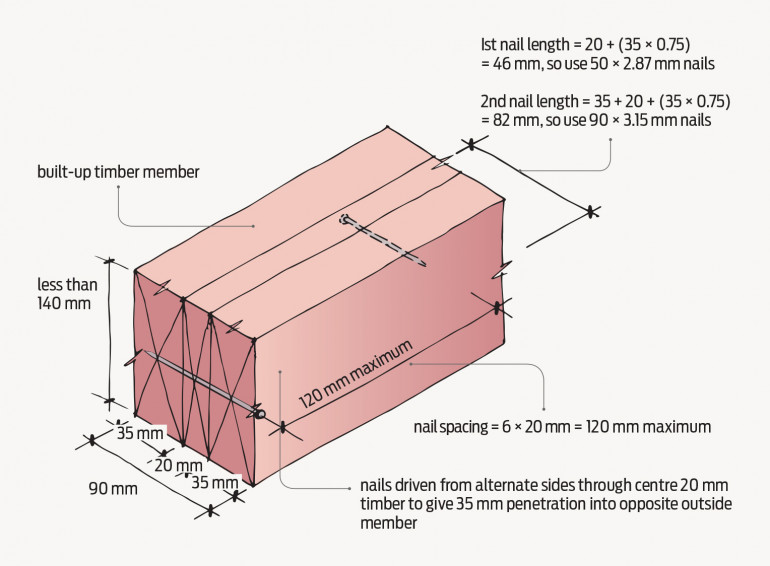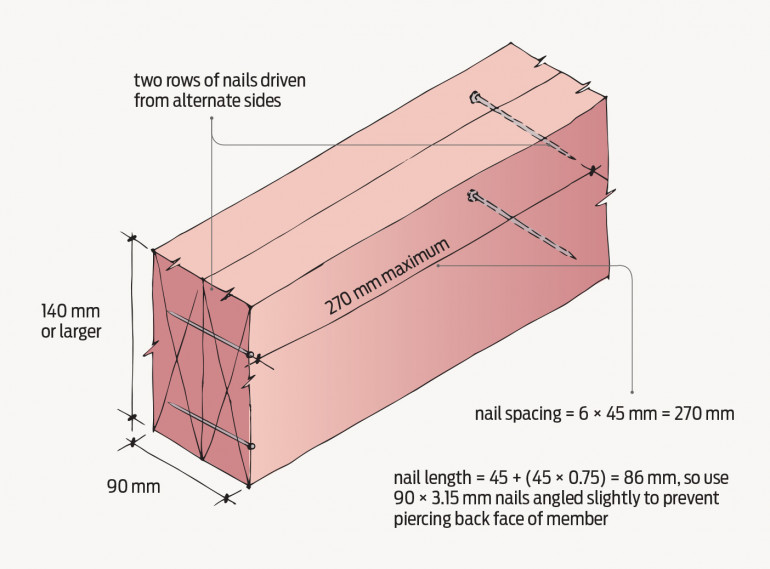Built-up members in place of solid timber
Codewords 87: December 2018
NZS 3604:2011 lets some solid timber members be replaced by built-up members. This article looks at how to do this correctly.

Jack studs and bottom and top plates must be solid timber members, but NZS 3604:2011 lets other solid timber members be replaced by built-up members. However, these need to be done correctly.
A built-up member is two or more component members used to make one larger member.
A few rules need to be followed when using built-up members. The built-up members must:
- be the same grade of timber
- be in one continuous length
- match or exceed the size of the solid member required in accordance with NZS 3604:2011 Timber-framed buildings.
Built-up members may consist of up to six component members nailed together according to the nailing requirements in NZS 3604:2011.
Built-up members of up to three components
The nailing requirements for built-up members of up to three components are that:
- the spacing of the nails is no more than six times the thickness of the thinnest component
- all nails penetrate at least three-quarters of the last component member
- nails are driven from alternate sides of the built-up member.
For example, a built-up member consisting of two 90 × 35 mm components and one 90 × 20 mm component must have:
- nailing spacings at 120 mm centres maximum (6 × 20 mm = 120 mm where 20 mm is the thinnest component member)
- nails that are at least 82 mm long (35 mm + 20 mm + (0.75 × 35 mm) = 82 mm) (Figure 1).
Figure 1: Built-up horizontal member less than 140 mm depth (for lintels and beams)

Image supplied by BRANZ Build magazine
When members are 140 mm or more in depth, at least two rows of nails are required, but the other criteria remain the same (Figure 2).
Figure 2: Built-up horizontal member 140 mm or deeper (for lintels and beams)

Image supplied by BRANZ Build magazine
Built-up members of more than three components
Where the built-up member consists of more than three component members, the first three component members should be assembled in the same way as a built-up member with up to three components.
NZS 3604:2011 is unclear, but BRANZ believes that additional component members should be fixed using nails that are twice as long and spaced at six times the thickness of each component member added (Figure 3).
Figure 3: Built-up member made of more than three vertical members (usually for trimming studs)

Image supplied by BRANZ Build magazine
Quiz
1. Which timber members may not be substituted with built-up members?
- Studs, top plates, joists
- Jack studs, top plates, bottom plates
- Joists, top plates, purlins
- Rafters, jack studs, lintels
2. Built-up members up to three components must be nailed at spacings:
- more than six times the thickness of the thickest member
- no more than six times the thickness of the thickest member
- no more than six times the thickness of the thinnest member
- more than six times the thickness of the thinnest member.
3. Nails must penetrate at least:
- half way through the last component member
- two-thirds of the way through the last component member
- three-quarters of the way through the last component member
- all the way through the last component member.
4. Where built-up members consist of more than three components, the first three components are nailed as for up to three component members. Additional layers must be nailed using nails:
- two times as long and spaced at less than six times the thickness of the component member added
- six times as long and spaced at less than six times the thickness of the component member added
- two times as long and spaced at six times the thickness of the component member added.
Check answers
1. Which timber members may not be substituted with built-up members?
b. Jack studs, top plates, bottom plates
2. Built-up members up to three components must be nailed at spacings:
c. no more than six times the thickness of the thinnest member
3. Nails must penetrate at least:
c. three-quarters of the way through the last component member
4. Where built-up members consist of more than three components, the first three components are nailed as for up to three component members. Additional layers must be nailed using nails:
c. two times as long and spaced at six times the thickness of the component member added.
